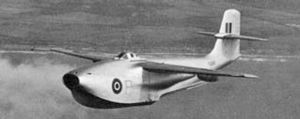Saunders-Roe SR.A/1 Video - Picture

|
|
Saunders-Roe SR.A/1

Role: Flying boat fighter
Manufacturer: Saunders-Roe
First flight: 16 July 1947
Retired: 1951
Status: Experimental
Primary user: Royal Air Force
Number built: 3
The Saunders-Roe SR.A/1 was a prototype flying boat fighter aircraft designed and built by Saunders-Roe. It was tested by the Royal Air Force shortly after World War II.
Design and development
The SR.A/1 was directly inspired by the (modest) successes experienced by the Imperial Japanese Navy with seaplane fighters such as the Nakajima A6M2-N (an adaptation of the Mitsubishi Zero) and the Kawanishi N1K. In theory, seaplanes were ideally suited to conditions in the Pacific theatre, and could turn any relatively calm area of coast into an airbase. Their main disadvantage came from the way in which the bulk of their floatation gear penalised their performance compared to other fighters. Saunders-Roe realised that the new turbojet engine presented an opportunity to overcome this drawback. Not requiring clearance for a propeller, the fuselage could sit lower in the water and utilise a flying boat-type hull. The company approached the Air Ministry with the idea then known as the SR.44, which led to specification E.6/44 and an accompanying development contract for three prototypes in May 1944.
The first prototype, piloted by Geoffrey Tyson, flew on July 16 1947, and while it and its two sisters proved to have good performance and handling, the need for such aircraft had completely evaporated with the end of the war. Furthermore, the success of the aircraft carrier in the Pacific had demonstrated a far more effective way to project airpower over the oceans. In addition, the cockpit canopy was small and heavily framed, giving the pilot a poor view outside the aircraft. A fundamental problem was that production of the Beryl engine had ceased when Metropolitan-Vickers had withdrawn from jet engine development, and only a limited number of engines were available. The project was suspended and the prototype put into store in 1950, but was briefly resurrected in November 1950 owing to the outbreak of the Korean War, before realisation of its obsolescence compared with land-based fighters and an inability to solve the engine problem forced a final cancellation, the prototype last flying in June 1951.
Although the aircraft never received an official name, it was referred to by company workers as 'Squirt'.
The two SR/A1 prototypes were fitted with the first two production Martin-Baker ejection seats built.
Operators
United Kingdom
Royal Air Force
Survivors
The first prototype, serial number TG263, has been preserved and is on display at Solent Sky aviation museum in Southampton. Both other aircraft (TG267 and TG271) were lost in accidents during the four-year flight test programme.
Specification
Data from British Flying Boats
General characteristics
Crew: 1
Length: 50 ft 0 in (14.24 m)
Wingspan: 46 ft 0 in (14.02 m)
Height: 16 ft 9 in (5.11 m)
Wing area: 415 ft² (38.6 m²)
Empty weight: 11,262 lb (5,108 kg)
Loaded weight: 16,000 lb (7,273 kg)
Powerplant: 2 x— Metropolitan-Vickers Beryl MVB.2 turbojets, 3,850 lbf (17.2 kN) each
Performance
Maximum speed: 512 mph (445 knots, 824 km/h)
Service ceiling: 48,000 ft (14,600 m)
Wing loading: 38.6 lb/ft² (188 kg/m²)
Thrust/weight: 0.48
Endurance: 1 hrs 48 min
Armament
Guns: 4x 20 mm Hispano Mk 5
Bombs: 2x 1000 lb (455 kg) bombs or rockets
Comparable aircraft
Convair F2Y Sea Dart
Footnotes
London, Peter. British Flying Boats. Stroud, UK:Sutton Publishing, 2003. ISBN 0-7509-2695-3.
Mason, Francis K.The British Fighter since 1912. Annapolis, Maryland, USA:Naval Institute Press, 1992. ISBN 1-55750-082-7.
Saunders-Roe SR.A/1 Pictures
More airplane videos.
Source: WikiPedia